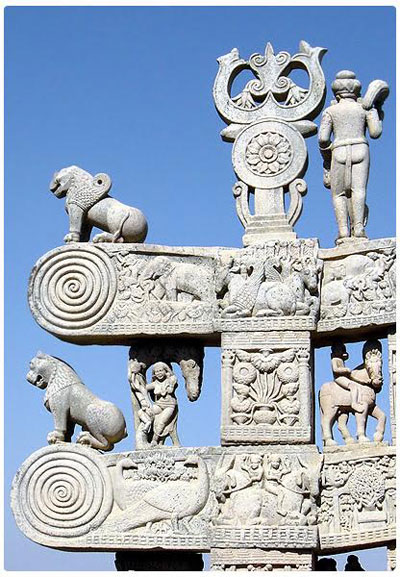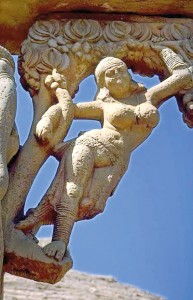Sanchi – Serenity and beauty on top of a hill

Sanchi-architraves at North gateway
It was during the third century BCE that the emperor Asoka built the first stupa here, when the then adjacent city of Vidisha (present day Besnagar) was an important centre on the empire’s great north-south trade route.
Over the ensuing years, subsequent rulers as well as travellers and traders along the route contributed to the upkeep and enhancement of the shrine. Today, although India’s main north-south railway still runs through Sanchi, the town is no longer on the country’s main trunk roads. It is usually reached by car from the state capital Bhopal about 50 km to the south-west, most visitors staying overnight in Bhopal and visiting Sanchi as a convenient day trip.
The shrine itself is situated on a peaceful hill that we reached after a gentle climb from the road. From the summit we had a magnificent view of the surrounding countryside – stretching out over fields and scrubland to the Vindhya hills in the distance. Because Sanchi (unlike India’s other Buddhist sites of pilgrimage like Bodhgaya and Sravasti), is not part of the main ‘package tour’ pilgrim circuit in Bihar state, it does not attract too many visitors. As a result we felt quite peaceful here, far away from the maddening crowds of pilgrims and tourists!
Stupa built by Emperor Asoka
Crowning the hill we found a group of ancient monasteries and stupas pervaded by a quiet serenity. Seated here underneath the neem trees in the stillness and bright sunshine, it was impossible not to feela sense of serenity in these surroundings, a sensation of there being “peace and holy quiet here.”
Although the Buddha himself never visited Sanchi, Emperor Asoka, probably in view of the city’s strategic importance, had the first stupa constructed here some 250 years after the Buddha’s death. It is said that his first wife Vidisha Devi, the mother of Arahat Mahinda, was a daughter of a merchant of Vidisha – and that it was she who influenced his decision to establish the shrine here.
About a century after it was originally built, the original brick construction was doubled in size and – although not as large as Anuradhapura’s Great Stupa, Jetavanaramaya - it is today one of the largest in India. Over the years were added balconies, gateways, railings and other buildings such as monasteries, preaching halls and travellers’ lodgings – along with intricate decorative sandstone sculptures carved in the first century BCE to replace the original wood and ivory carvings.
Scenes from the Buddha’s Life
The four carved sandstone gateways at Sanchi are among the finest examples of Buddhist toranas anywhere in the world. Situated respectively at the north, east, south and west entrances to the shrine, they each consist of two pillars joined by three cross beams (called architraves) which are carved as if they actually pass through the uprights. The entire surface of the four toranas is covered with rich carvings depicting scenes from the Buddha’s life, his seven incarnations and the miracles he performed.
Art of Pre-Gandhara Period

Statue of female figure at Sanchi
These works of art were created in the pre-Gandhara period, before it became fashionable to depict the Buddha’s human form. Consequently, the Buddha is represented in these friezes by images like a Bo tree, a wheel, a tree or a stupa. There are other images – one that I found particularly attractive was that of the female figure with a very modern hairstyle at the edge of the South torana. She appears so beautiful and lifelike, as she reaches out to pluck a mango from an overhanging branch!
Whether you are a Buddhist devotee, a student of history or just a tourist, Sanchi is well worth a visit. You can fly to Delhi and then travel to Bhopal either by air – or take the seven hour trip on the luxury Shatabdi Express. From Bhopal it takes just over an hour by road to Sanchi.


